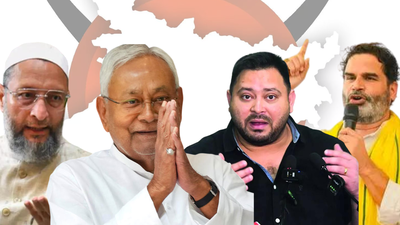In the 1990s, the powerful “MY” (Muslim-Yadav) vote bank propelled Lalu Prasad Yadav to the summit of Bihar politics. Today, as his eldest son Tejashwi Yadav aims to repeat that feat, the crucial question is: which way will Muslim voters swing? With Prashant Kishor’s pledge to field 40 Muslim candidates and Asaduddin Owaisi’s Grand Democratic Alliance, the answer might be more complex than ever. Filing of nominations for the first phase of polling closed on Friday, with over 1,250 candidates entering the fray for 121 seats to be contested on November 6. The remaining seats will go to the polls on November 11. The NDA, led by chief minister Nitish Kumar’s JD(U) and the BJP, appears united and confident, while the opposition Mahagathbandhan, comprising the RJD, Congress and Left parties, is struggling with internal rifts and overlapping candidacies.JD(U) has released its complete list of 101 candidates, giving prominence to backward and extremely backward classes, but only four tickets to Muslim candidates. This limited representation has raised questions about whether Nitish Kumar’s party has moved away from its earlier efforts to engage minority voters, given its long-standing alliance with the BJP. In contrast, Prashant Kishor’s Jan Suraaj has pledged to field 40 Muslim candidates, while AIMIM, led by Asaduddin Owaisi, has joined hands with smaller outfits under the Grand Democratic Alliance (GDA), announcing plans to contest 64 constituencies. The Election Commission’s 2022 caste survey revealed that Muslims make up 17.7% of Bihar’s population, about 23 million people, and hold significant influence in nearly 70 of the state’s 243 constituencies, particularly in Seemanchal districts such as Kishanganj (68%), Katihar (43%), Araria (42%) and Purnia (38%). With multiple parties now targeting the same voter base, the split in the Muslim vote could once again shape the outcome.
A shifting bloc
Muslim voters have historically been pivotal in Bihar’s electoral politics, often voting as a bloc in support of secular coalitions. The 2010, 2015 and 2020 elections reveal how shifts in alliances and vote splits have impacted their representation. In 2010, the RJD fielded the highest number of Muslim candidates at 30, but only six won. Congress performed even worse, with only three of its 49 Muslim candidates winning all from Muslim-majority constituencies like Kishanganj, Kasba and Bahadurganj. The JD(U)-BJP alliance, then riding high on Nitish Kumar’s first term as chief minister, won a large share of seats, including in areas with substantial Muslim populations, mainly due to the consolidation of non-Muslim votes.Five years later, in 2015, the political landscape shifted dramatically. The RJD, JD(U) and Congress came together under the Mahagathbandhan banner, drawing nearly 80% of Muslim votes. This alliance resulted in the election of 24 Muslim MLAs, up from 19 in 2010. The RJD had 12, Congress six, JD(U) five, and the CPI-ML one. Four MLAs came from Muslim-dominated Kishanganj, three each from East Champaran and Purnia, and two each from Araria, Darbhanga and Katihar. Notably, the AIMIM failed to make a mark despite contesting six seats in Seemanchal. The BJP, which had fielded only two Muslim candidates, saw both lose. As RJD’s Abdul Bari Siddiqui pointed out at the time, the increase in Muslim representation was welcome but still fell short of reflecting their 16% population share.The 2015 results reaffirmed the strength of the “MY” (Muslim-Yadav) coalition, long seen as the backbone of RJD’s social base, and marked a period of renewed confidence among minority voters in mainstream alliances.
2020: Return of vote splits
The 2020 assembly election once again saw fragmentation in Muslim voting patterns. The Grand Alliance, now led by Tejashwi Yadav, weakened as Owaisi’s AIMIM gained ground in Seemanchal, winning five seats. Although four of those MLAs later defected to the RJD, AIMIM’s performance underscored its growing appeal among young Muslim voters disillusioned with both the RJD and Congress. The RJD fielded 18 Muslim candidates, out of which eight won, while the Congress had 11 Muslim candidates and managed only four victories. The JD(U), despite being part of the NDA, failed to elect any Muslim MLA. In total, 19 Muslim legislators made it to the assembly, five fewer than in 2015.The 2020 election marked the end of a decade-long trend of consolidation and a return to fragmentation. While the Grand Alliance retained support in several mixed constituencies, AIMIM’s entry in Seemanchal altered traditional vote patterns, cutting into the secular coalition’s base and indirectly benefiting the NDA.
Same forces, new dynamics
As the 2025 election nears, political alignments are shifting. The RJD-Congress alliance remains the largest opposition bloc but is struggling with clear disagreements over seat-sharing. At the same time, AIMIM has formed the Grand Democratic Alliance with Chandrashekhar Azad’s Azad Samaj Party and Swami Prasad Maurya’s AJP, introducing fresh competition for the Muslim vote.Meanwhile, JD(U) and BJP’s joint strategy seems aimed at consolidating the majority vote while conceding limited ground to minorities. With Muslims influencing nearly one-third of Bihar’s constituencies, how this community votes, united or divided, will once again determine not just the number of seats won, but who governs the state. Go to Source


